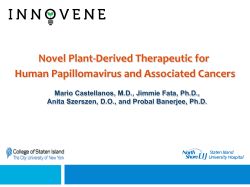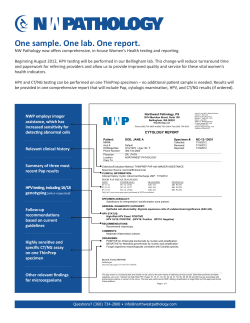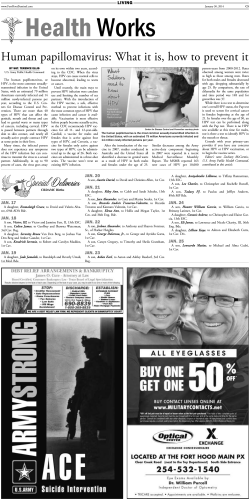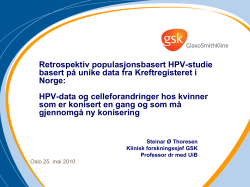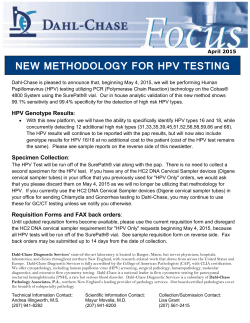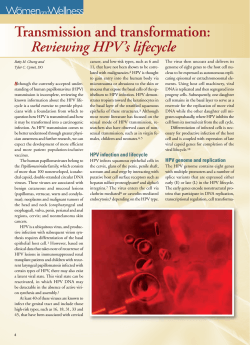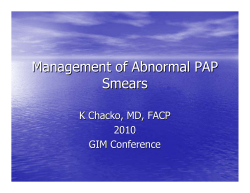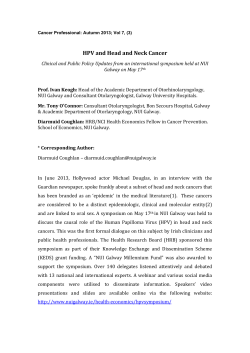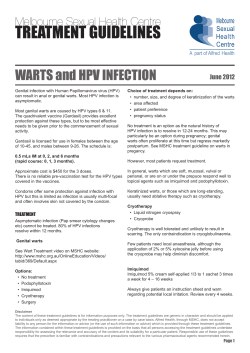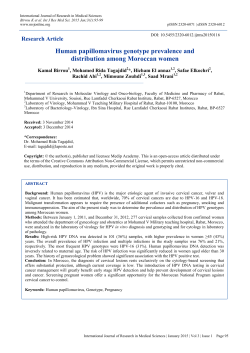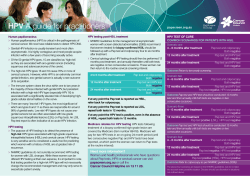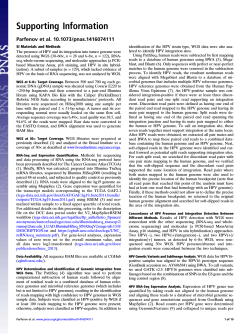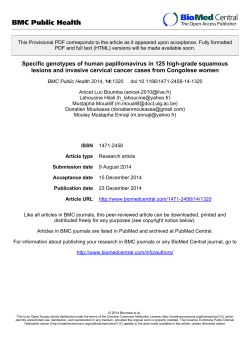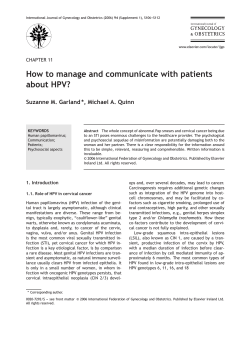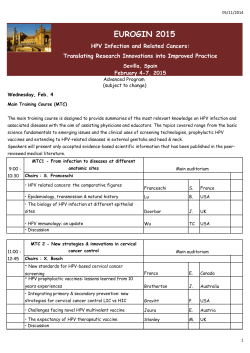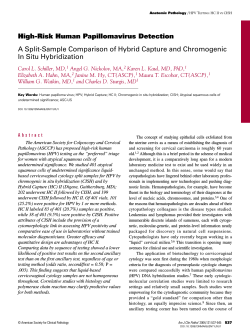
Document 145865
DNA LABS ORAonL s ry nostj Innovati in Saliva Diag 1 -877-57 wwwQraIDNA corn/professionals The nation’s leading business journal for the profession Oral Cancer and the GP dentist: An interview with Ronald C. McGlennen, MD A°LBs ORALDN c vcceeancsnnc olso jnoeowvnmnsa 1.RISK Ordering Provider Doe, Jane P. 1/1980 Odin 01 SkIll, 01/0 Gender Fonratn e Sample Islormatior 6519.39 Ronelnad: 11/30/20 21.12 65 Rnponted: 12/01/20 921 12 PnSnled:12/011260 531 Scceusnon: 6006 0 spoconan: Oral 0105 1939 2505 collected. th/2& 10 10 IDENTIFIED HIGH RISK HPV Result: POSITIVE Test Intonm0500 - Presences? I Reason Ion test: ied Patient Rick HPV Type(s) Identif p. T y 6 le LesIon SIenn High Mined Types Lesion Color: : i.eldon LeasUon nce C/In/al SIgnIfica er deceinpnionm St canc s/nigh IDeS Or DO clan/led as hem The HPV Type is decelcponenl ci lUgEr ncr or Cs 400/cc n 5(krsn Rod Coo Pa/ale P.ddlllon.l CyniCal tetepecatloy: 0 of clans/lied as heWn The Spy Types considered a s HPV infection is type(s) (1618). Thi comment. iratory tract. See the following I-fPV resp for e oro itiv pos the is of ia or neoplas This sample ment of dysplasia elop dev for risk high h.tenpretaeon: tact with son to person con the tonstls t is caused by per the oral roucosa, ororespiratory trac ing olv the inv of se V HP tho : s such as the morphologic • Significance elopment of cancer plasia and cancer are based on dev the for s tion implica of dys biopsy. gue. The diagnosis cimen obtained from and the base of ton logy or tissue spe uding the time assessment of a cyto several factors incl there are L-IPV type involves status and whether ignancy. The nt of risk of a given une me ign imm ass and The nal hormo risk of mal • Risk: ction, the patients rease the general have been ses viru duration of the infe its or underlying disease that inc se meaning that the coincident social hab this sample is listed as high risk, in d tifie s. iden cell infected HPV type ignant changes in n is close associated with mal h risk HPV infectio the result of a hig n s) later. endatio following nth mm mo 2 reco r(1 t ren yea cur sistent HPV one Consider: A eeeae repeat testing for per spranarsW,eboeemI ReasDon(PC9Icse0lmg.nen.Sw.eJl,.pSal observation and IDsllrrrenase dm0 Comment sod by 0.gaslnd ON/c oon torn ,, mescrcrte000ynre, lod apanInen and sire/ ad*en ire scbnrrS ods wore subieded 0 d.goS000 by tssg see lIsgerema p0551010 ir0S ole/c s/c 050 ces eeo.O narc prnd MaAredolUsJr Demon Sesame tIDy DNA p0,16cc P00 nd HPVgenclgpa dolenriflOd by pW skb Snm e.rsbten paete bydde*edass iosd l 1 ole/a P ,eae ul 0 a5d cons c boJ p N5E a D 9 emngIe ore. DisUsle also/ oasloI/ar0,llIbAlebp ymelee/ce end d.dd 55110509 enannenl OcalOrM.sseO teens/able toe inns Snqm*ernods. II basest been destde ncS onmg hem 2 pOreusni 50 CU* Sable leraPy ebSc05 lrd bypaA500,n0,Adeeerdalon Ire not . Lab, 5 NA OrSIO reaCslnd OteabteemP. 1. 0N rsuolu not neussoary .aerlae detenlolad by oos so edoero penlonnarree caoo dent*rad Vial Sod. cleeocree osey Øyald.,etee,rba 1 em deoelopsd *eSoer. T1 FDA SM ue.cior. a. its Feed end Drug /cdn epyrsoed by Ire U.S. 05/ItO 0/8159/0 b050l Saeln QtvcoFrc sdlsc P.abavl.QgncTluco .omeldrracoen 6156272626 a.nae 6155279055: FeD, an, 5,1, tor Ronald McGlom. Modeat 0/sec — srceyc ..... cossnnr.0 pnfia5IeID0or .— Michael Douglas, oral cancer, and the GP dentist: An interview with Ronald C. McGlennen, MD by Dr. Joe Blaes Ri\’IcG: I am pleasantly surprised that so many reporters did their homework and sought Out experts who were able to explain that, although oropharvngeal cancer has been traditionally associated with tobacco use and alcohol, the This month’s interview is with Ron McGlennen, MD. chief fastest-growing risk factor for this disease is infection with medical officer of OralDN4® Labs, Inc., a leading provider of human papillomavirus (HPV). salivary diagnostic tests to the dental profession, and a subsidiary of Quest Diagnostics®, Inc. Di: IcGlennen is board—certified in Di: Blaes: The at—risk profile seems to have changed overnight, es anatomic and clinical pathology, and is also board—certified by the peciallyfor those who have been practicing dentistryfor many years. American Board ofMedical Genetics, with a specialty in clinical R?VIcG: There are many dentists who may read statistics molecular genetics. He is internationally recognized as an expert such as, “Of the 34,000 cases of oropharyngeal cancers in molecular biology and genetics. diagnosed each year, HPV is now found in up to 50% of them,” and say to themselves, “When did this happen?” Di: Blaes: When Michael Douglas announced on the David Letterman Show that he had Di: Blaes: Or why did this happen? Stage IV throat cancel; he received a lot of RMcG: Exactly! The reason why can media attention as one would expect. What be attributed to increased sexual activity does this widespread news coverage mean to with multiple partners at a younger age, the dental profrssional? and the widespread misperception that RMcG: One of the results of Mr. Doug oral sex is safe sex. las’ unfortunate oropharrngeal cancer di agnosis is that more people are now aware Di: Blaes: Are there any differences between of oral cancers, and that this disease does HP V—positive and HPVLnegative cancers? not discriminate between celebrities and RMcG: There are actually two main regular folks. This heightened aware differences: First, oropharyngeal cancer ness and concern has prompted people when caused by HPV has a higher sur to make appointments with their dentists vival rate than cancer caused by tobacco and ask specific questions about risk fac and alcohol use. Second, the oral HPV in tors, diagnosis, and treatment. fection can now be detected long before physical symptoms occur. Di: Blaes: Although IVlichael Douglas had access to the best medi cal care available, his tumor was not detected until it reached Di: Blaes: Why is the survival rate higher when orophaiyngeal Stage IV Why do you think it took so long to diagnose? cancer is caused by HPV? RMcG: I cannot provide a definitive answer because I was RMcG: According to a study published in the June 2010 not part of his clinical team. But the fact that his tumor edition of the New England Journal of Medicine, the most was at the base of the tongue may have made it difficult important factor is that HPV-positive oropharyngeal squa to be detected by the naked eye or by using an adjunc mous-cell carcinomas actually responds more favorably to tive screening device. Other risk assessment tools, such as chemo and radiation treatment modalities. The reason for salivary diagnostic tests, that do not require line-of-sight this may be that HPV-positive tumors have lower levels of inspection need to be utilized much earlier. This is espe a certain growth factor receptor called EGFR. cially true when the patient is complaining about persistent symptoms, such as a sore throat, and fits a high-risk profile, Di: Blaes: IfI Iichael Douglas has been given a positive prognosis such as using tobacco and alcohol. ofan 80% survival te is it because his cancer is HP V—related? RMcG: This has been widely speculated, especially since Di: Blaes: There has been a fairly common sidebar to this news his cancer is being treated with chemo and radiation ther coverage the link between oral HPV and oral cancei: Does it apies. But at this time, it is just the speculation of many suiprise you? medical reporters who are trying to connect the dots. For more on this topic, go to www.dentaleconomics. corn and search using the following key words: Michael Douglas, oral cancel; Di: Ronald McGlennen, Di: Joe Blaes. Reprinted with revisions to format, from the November 2010 edition of DENTAL ECONOMICS Copyright 2010 by PennWell Corporation Michael Douglas, oral cancer, and the GP dentist Di: Blaes: Can 01-al HPV be detected before it progresses into a cancerous tumor? Di: Blaes: Speaking of results, what if the lab report comes back positive? RIVIcG: Yes. That capability became reality early this year RMcG: If the test comes back positive, but there are no visible lesions, then the dentist should recommend that the test be readministered in a follow-up appointment within the next six months, or based on the existing pro tocol for oral cancer exams. Very often the oral HPV infection will be eliminated by the patient’s immune system. But if a follow-up test indi cates persistent HPV infection, referral to an ENT or oral surgeon is recommended. If the test comes back positive and there is an oral le sion visible to the naked eye or via an adjunctive screening device, the patient should be referred to an oral surgeon or ENT. OraIDNA provides complete referral protocol workfiow charts for all possible test result scenarios. when Ora1DNA Labs introduced its OraRisk” HPV test a tool for identifying the various types and levels of oral HPV infection, espe cially HPV-16 and HPV-18, the variants most commonly linked to oral cancer. noninvasive, easy-to-use screening — Di: Blaes: HPV hasn ‘t been in the headlines this niuch since the launch of Gai•dasif. Now the discussion is about the oral variety ofthe virus. Does this put dentists on the front lines, and are they ready to lead the charge? RMcG: Dentists-v has been gradually evolving into an oral medicine discipline, and these recent developments may help to speed up the process a bit. Dentistry is also evolving from a “disease-oriented” model to a “wellness oriented model.” This provides an excellent for all dental professionals to detect disease earlier, de termine who is more at risk, and ensure better patient outcomes. However, this evolution is bringing increased respon sibility. Dentists need to step out of their clinical comfort zones, and deal with life and death situations or ask very personal questions. opportunity Di: Blnes: You ,,,ean questions to determine whether or not pa tients may be at risk for HPV? RMcG: Thats right. Here is a list of questions that a dental clinician would ask a patient to determine whether he or she is a candidate for a salivary oral HPV test: • • • • Do you have a family history of oral cancer? Do you smoke or chew tobacco? Do you frequently drink alcoholic beverages? Are you sexually active? The last question is going to have to be rehearsed, along with an explanation of why it is important for the dentist or hygienist to ask. What’s more, these questions will prob ably have to be asked in a private room rather than a mul tiple-chair operatory setting. Di: Blaes: The chphoai-d with the patient histoiy info may have to be filled out in privag as well. RMcG: The last thing you want is for patients to not an swer the questions honestly because they think someone be looking over their shoulder. You may also need to designate a woman member of your dental team to have this discussion with female patients, and a parent needs to be included when talking about Oral HPV with a minor. Ora1DNA Labs also provides a clinician education kit that includes sample scripts and how to discuss the OraRisk test and its results with a patient. may practice’s Di: Blaes: Will salivary diagnostic testing change the business of dentistiy? RMcG: There’s no doubt in my mind. First, dentists can take full advantage of advanced salivary diagnostic technol ogy with no capital investment. Salivary diagnostic tests for oral HPV and periodontal disease can easily be incorporated into a patient’s six-month or annual hygiene appointment. Whats more, with more than 150,000 practicing general dentists in the U.S., no other dental specialty can screen as many patients and have as great an impact on early detec tion and improved patient outcomes. Specialists will benefit from referrals from the front lines, plus they will see patients earlier when their treat ment of periodontal disease or oral cancer will result in a greater number of successful outcomes. I also believe that dentist and hygiene appointments will evolve into “wellness appointments” as more salivary tests are introduced and folded into these regularly scheduled opportunities to see patients. This will elevate the level of importance of these periodic appointments, which may in turn reduce the number of cancellations, and increase patient acceptance of additional diagnostic tests and treat ment plans. The general dentist’s stature as a clinician will be el evated as an important part of a patient’s diagnostic and wellness management team. Ultimately, salivary diagnostic tests can also dental practice’s productivity and boost its bottom line. DE improve a Ron McGlennen, MD, is the chief medical officer of OraIDNA Labs, and is board-certified in anatomic and clinical pathology. He is also board-certi fied by the American Board of Medical Genetics with a specially in clinical molecular genetics. Dr. McGlennen is internationally recognized as an expert in molecular biology and genetics. He can be contacted at rmcglennen@oraldna. cam. a . 4 Ora [DNA® Labs Advancing Patient Weitness Through SaLivary Diagnostics Helping patients fight the battle against existing disease is a noble cause, but imagine if you could help them win the fight even before disease has a chance to take hold. With salivary diagnostic tests from OralDNA© Labs, you now have the ability to learn more about your patients oral health even before clinical signs and symptoms appear. Our tests are based on a wellness model that strives to keep patients healthy by allowing you to detect disease earlier, determine who is at risk, and put them on a path toward a lifetime of overall heaLth and wellness. It’s amazing what we can find out from a few drops of saLiva. It’s even more amazing what you can do to help patients with that knowLedge. Learn more about OraIDNA® Labs and salivary diagnostics www.OralDNA.com/professionals 877.577.9O!F Access Genetics/ORALDNA 7400 Flying cloud Drive Suite 150 Eden Prairie, MN 55344 5 Labs Inc. All Rights Reserved © 2011 OraIDNA 8 LABS ORALDNJ Innovations in Salivary Diagnostics
© Copyright 2025
